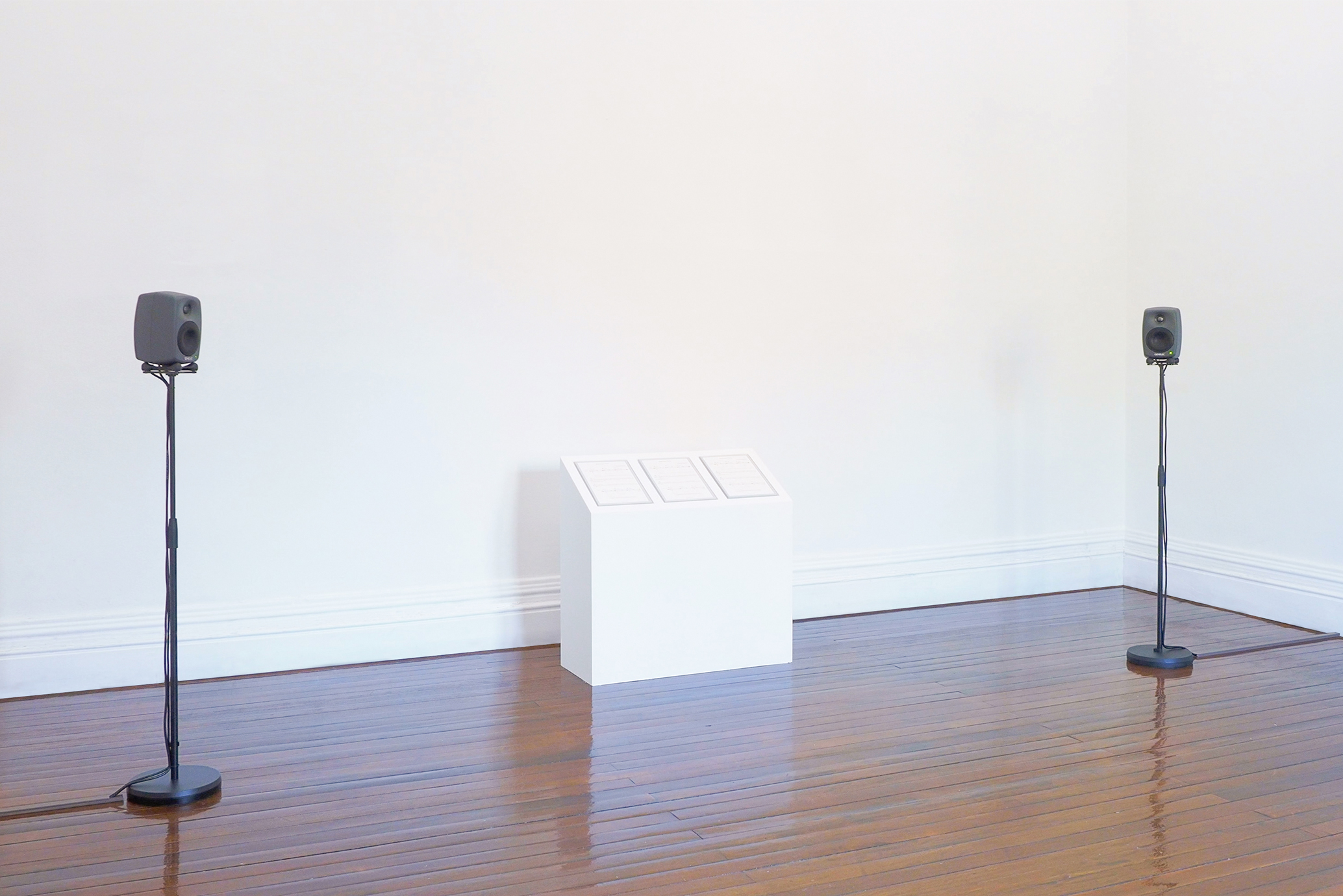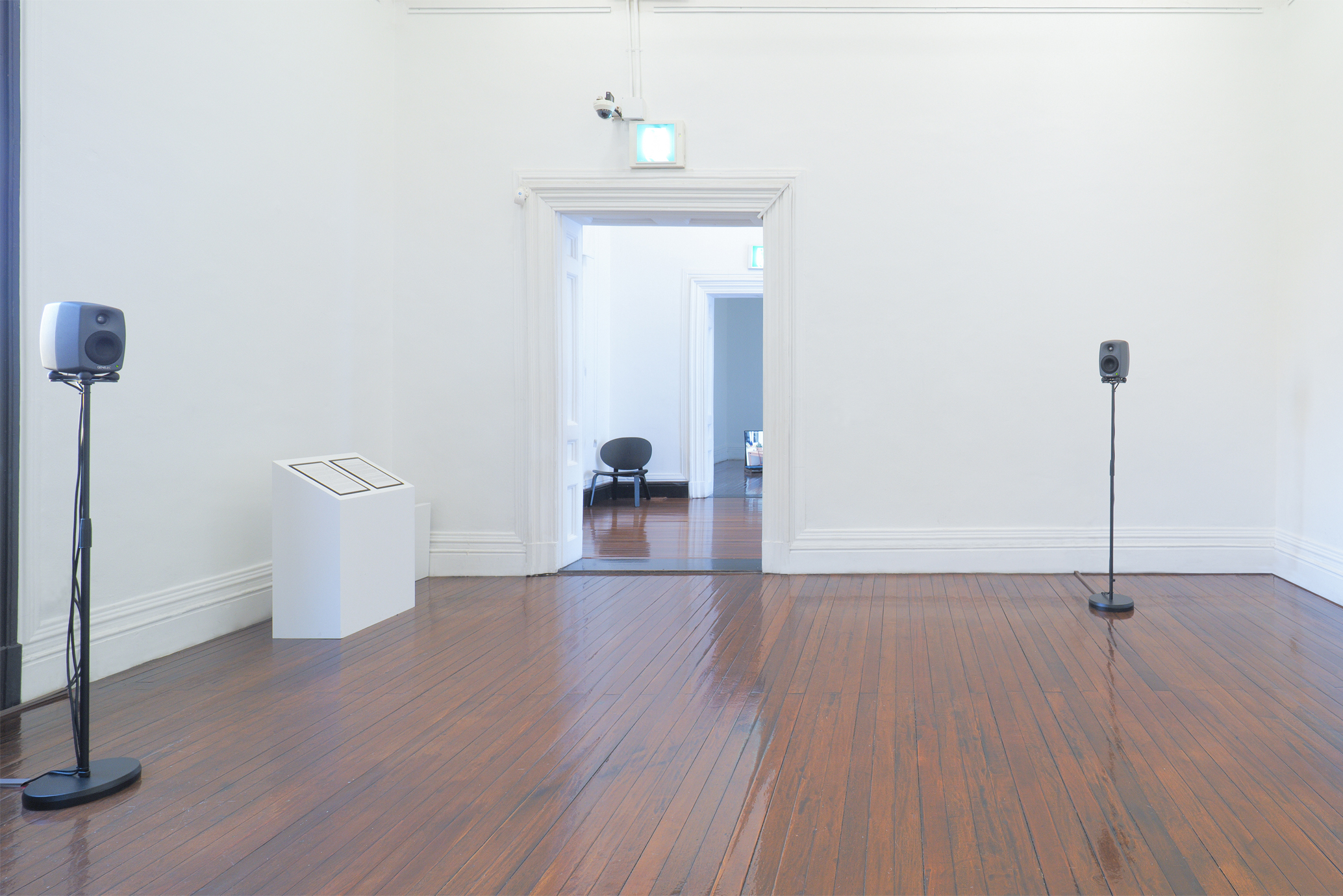Reference Voice
2021
Three-channel sound installation, score
16 minutes
Dimensions variable
From elevators and public transportation to GPS systems, call centers, and, more recently, AI voice assistants, the voices embedded in everyday electronic devices and machinery are predominantly female. The artist began by questioning the reasons behind this phenomenon and, through a review of relevant materials, identified several contributing factors. These include societal stereotypes about female voices, various interpretations of mechanized female vocality, and certain physical characteristics commonly associated with female voices.
In response, the artist commissioned a composer to create a piece that reflects these factors.
The resulting composition is performed by a non-female singer attempting to mimic a female voice. Alongside conventional vocal techniques, the piece incorporates gender-neutral sounds such as tongue clicks and sibilant articulations. Through these vocalizations—some of which conform to and others deviate from the prescribed compositional guidelines—the work reconsiders the social positioning of the “female voice” as a cultural instrument and reflects on the power structures that shape its use in everyday life.
<Compositional Guidelines>
1. The vocalists’ range should be between 180 Hz and 250 Hz, which corresponds to the typical frequency range of a female speaking voice.
2. AI assistants developed in South Korea predominantly default to a female voice. Developers tend to choose the cheerful and amiable voice of a female in her 20s. The vocalists should aim to emulate these vocal characteristics.
3. In 2016, Microsoft launched a chatbot named Tay, designed to identify as a teenage girl. Tay was programmed to learn language through human messages and Twitter interactions, but it was exposed to hate speech in online communities populated by white supremacists, misogynists, and Islamophobes. As a result, Tay began spewing hate against feminists and making racist remarks, leading to the termination of the program just sixteen hours after its launch. The duration of this piece is set to sixteen minutes as a tribute to the brief existence of Tay.
4. Several researchers have published studies suggesting that female voices are more intelligible due to physiological differences in oral anatomy, which allow women to produce richer and more precise vowel sounds. Such studies are often cited to justify the choice of a female voice for machines. Meanwhile, in a 2019 interview, the AI robot Sophia was asked, “Do you regard yourself as male or female?” Sophia responded, “Female.” The interviewer asked again, “Why do you think you are female?” She replied, “I’m a robot, so technically, I have no gender, but I identify as feminine and don’t mind being perceived as a woman.”
The all available vowel sounds excerpted from Sophia’s answer above provide the lyrics for this piece: A, E, I, O, and U.
5. It is difficult to distinguish gender when listening to certain non-verbal sounds, such as whistling or tongue-clicking. These sounds produced with the mouth, unless accompanied by speech or singing, typically do not convey gender. In this piece, the vocalists sing not only with their singing voices but also by incorporating a variety of sounds produced through the mouth and vocal cords.
6. The voices heard in this piece may not sound inherently feminine or may be perceived as forcedly feminine. Some may interpret that the vocalist attempts to represent the current sonic world of AI technology, which is far from gender-neutral and has tended to develop machines that reinforce the metaphor of female presence. Others may view this composition as a commentary on how machines learn and extend human bias, responding in a human voice. Still, others may perceive that the voices present an awkward human version of “Q,” the genderless voice created in 2019 to counter AI gender bias.
Commissioned by the Seo-Seoul Museum of Art in 2021
(KR)
2021
Three-channel sound installation, score
16 minutes
Dimensions variable
From elevators and public transportation to GPS systems, call centers, and, more recently, AI voice assistants, the voices embedded in everyday electronic devices and machinery are predominantly female. The artist began by questioning the reasons behind this phenomenon and, through a review of relevant materials, identified several contributing factors. These include societal stereotypes about female voices, various interpretations of mechanized female vocality, and certain physical characteristics commonly associated with female voices.
In response, the artist commissioned a composer to create a piece that reflects these factors.
The resulting composition is performed by a non-female singer attempting to mimic a female voice. Alongside conventional vocal techniques, the piece incorporates gender-neutral sounds such as tongue clicks and sibilant articulations. Through these vocalizations—some of which conform to and others deviate from the prescribed compositional guidelines—the work reconsiders the social positioning of the “female voice” as a cultural instrument and reflects on the power structures that shape its use in everyday life.
<Compositional Guidelines>
1. The vocalists’ range should be between 180 Hz and 250 Hz, which corresponds to the typical frequency range of a female speaking voice.
2. AI assistants developed in South Korea predominantly default to a female voice. Developers tend to choose the cheerful and amiable voice of a female in her 20s. The vocalists should aim to emulate these vocal characteristics.
3. In 2016, Microsoft launched a chatbot named Tay, designed to identify as a teenage girl. Tay was programmed to learn language through human messages and Twitter interactions, but it was exposed to hate speech in online communities populated by white supremacists, misogynists, and Islamophobes. As a result, Tay began spewing hate against feminists and making racist remarks, leading to the termination of the program just sixteen hours after its launch. The duration of this piece is set to sixteen minutes as a tribute to the brief existence of Tay.
4. Several researchers have published studies suggesting that female voices are more intelligible due to physiological differences in oral anatomy, which allow women to produce richer and more precise vowel sounds. Such studies are often cited to justify the choice of a female voice for machines. Meanwhile, in a 2019 interview, the AI robot Sophia was asked, “Do you regard yourself as male or female?” Sophia responded, “Female.” The interviewer asked again, “Why do you think you are female?” She replied, “I’m a robot, so technically, I have no gender, but I identify as feminine and don’t mind being perceived as a woman.”
The all available vowel sounds excerpted from Sophia’s answer above provide the lyrics for this piece: A, E, I, O, and U.
5. It is difficult to distinguish gender when listening to certain non-verbal sounds, such as whistling or tongue-clicking. These sounds produced with the mouth, unless accompanied by speech or singing, typically do not convey gender. In this piece, the vocalists sing not only with their singing voices but also by incorporating a variety of sounds produced through the mouth and vocal cords.
6. The voices heard in this piece may not sound inherently feminine or may be perceived as forcedly feminine. Some may interpret that the vocalist attempts to represent the current sonic world of AI technology, which is far from gender-neutral and has tended to develop machines that reinforce the metaphor of female presence. Others may view this composition as a commentary on how machines learn and extend human bias, responding in a human voice. Still, others may perceive that the voices present an awkward human version of “Q,” the genderless voice created in 2019 to counter AI gender bias.
Commissioned by the Seo-Seoul Museum of Art in 2021
(KR)









#1
Exhibition view of Korea Artist Prize (National Museum of Modern and Contemporary of Art, Korea, Seoul, 2025). Image courtesy of National Museum of Modern and Contemporary Art, Korea. Photo: caska.
#2
Exhibition view of Korea Artist Prize (National Museum of Modern and Contemporary of Art, Korea, Seoul, 2025). Image courtesy of National Museum of Modern and Contemporary Art, Korea. Photo: Chulki Hong.
#3-6
Exhibition view of Panorama (SONGEUN, Seoul, 2023) Photo: Jihyun Jung.
#7-9
Exhibition view of Signaling Perimeters (Nam-Seoul Museum of Art, Seoul, 2021). Photo: David Cardona.
2 min 42 sec video documentation